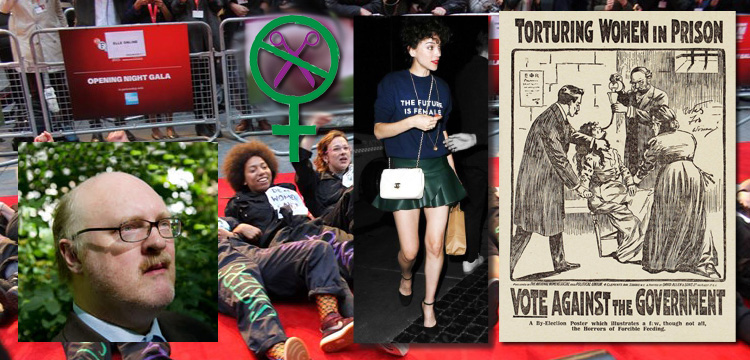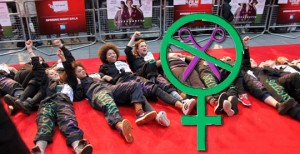The Future is Female by David Morgan, Journalist, editor, researcher and commentator on political, historical and human rights issues.
The state of the world might easily leave one in utter despair. The achievement of social justice for all seems a matter for idealistic dreamers, the welfare state safeguards that offered many the only hope of a half-decent existence (I won’t say “life”) are systematically eroded, while wars, conflicts and deep social divisions in power and wealth are tearing the world asunder. The refugee crisis in the Mediterranean is a huge catastrophe with suffering on an unbearable scale unfolding before the world’s gaze while empathy is far too feeble and fleeting to address the real roots of the problem.
Bombing is presented as the only solution to resolve such conflicts as that in Syria and where it has become an indication of a state’s virility to bomb and who can bomb the most often and the most relentlessly.
Despite all the horrors of war, terrorism and violence, 2015 in many respects was a positive year for women in society. Women have been organising in new movements, launching campaigns and taking political action against the abusive behaviour and power structures that oppress them and make their lives intolerable. Their resistance has achieved some notable successes despite the formidable obstacles and challenges that confront them.
Out of the turmoil of Syria the Rojava revolution has seen the Kurds take control of their region in the northern part of the country where they have established a new system of democratically run assemblies in which women have an equal representation. Kurdish women are also inspiring people worldwide by taking up arms in defence of their community and they have shown formidable resistance to the onslaught waged by Islamic State (ISIS) in Kobane. The participation of women has a central place in the new ideology of the Kurdish movement as developed by their jailed leader Abdullah Ocalan, who is possibly unique among Middle Eastern political leaders in his espousal of feminism.
Today’s world could do with a little more of this feminist activism and influence. Almost thirty years ago, the feminist activist and author, Lynne Segal, in a seminal work, posed the question, Is the Future Female? She seemed reluctant however to answer in the affirmative, which was understandable given the negative political trends then prevalent, not least of which was the threat of nuclear annihilation which seemed all too real in the belligerent 1980s. This was a decade when British Prime Minister Margaret Thatcher denounced ‘’godless Communism’’ and US President Ronald Reagan adopted the strategic defence initiative (known as “Star Wars”) in order to bankrupt the Soviet Union; it was a time when the Chernobyl disaster dispersed radioactive pollution across Europe and when the new Cold War teetered on the brink of becoming a very hot one.
Today, “international terrorism” seems by comparison a less serious threat, but for those who have not lived through these Cold War tensions, ISIS are a real and present danger. This group has revived medieval forms of torture and brutality, all too familiar from the propaganda films that they have produced to celebrate all the head chopping and severing of limbs. In addition, to throwing victims from high buildings, burying and burning other victims alive, ISIS has even been dragging living victims through the streets tethered to the back of a moving vehicle, just like the tyrants of old would drag defeated enemies from the back of a chariot until they expired. Much of the focus for ISIS violence has been directed at women. They tremble in fear at the thought of independent women, and if they cannot control them, they kill them.
Apart from these wars and conflicts, climate change and environmental destruction wreak havoc on Mother Earth. Our very survival as a species is once again at stake. But despite all this gloom and horror, there is hope for humanity in the numerous struggles of women for justice and equality in Britain and around the world. Women are increasingly active in resisting oppression, sexual violence, sex slavery, rape, abusive partners, poor working conditions and social injustice of various kinds.
It is inspiring that some women now have the confidence to express a positive response to Segal’s still timely question. “The Future is Female” was the assertive slogan defiantly displayed on the sweatshirt worn by musician Annie Clark (who performs under the name of St Vincent, a name chosen in honour of the American feminist poet, Edna St Vincent Millay). A day later, the paparazzi happened to photograph her partner, the British model turned actress, Cara Delevingne, wearing exactly the same style of sweatshirt, perhaps the very same garment, which baffled some of the fashion journalists who thought it was extremely uncool.
“One is not born, but rather becomes a woman,” is an insight from Simone de Beauvoir which points to a process of socialisation that equally applies to men. It is our conditions of existence and experiences that shape and inform who we are, but that we can shape and take control of our own lives once we recognise this. In Cara Delevingne’s changing career, one sees a young woman gradually becoming her own person, growing in confidence and asserting her true independence. She has bravely confessed to having suffered from depression which she successfully conquered and has explained that she now wanted to share her experiences in order to help others to deal with their own depression. Her growing stature has allowed her to challenge abuses in the fashion industry and the wider media where young women are the victims of predatory older men who have all the power to make or break a career. By boldly speaking out she is taking a firm stand against the objectification and sexualisation of all women.
A danger comes from those women who believe that they are empowered by adopting male behaviour patterns and attitudes to advance their professional careers because this individualism leaves the mass of their sisters languishing behind. This is feminism that accommodates itself to capitalism which only has value in enabling more women to climb the social ladder and enter the boardroom. This will not of itself change the world for the betterment of all.
An extreme example of women becoming like men is seen in the rise of the girl gangs in the big cities. This worrying trend is part of an increase in reported violent street crimes committed by young women and girls. There have been several cases such as the incident on 21 October when a 13 year old girl was arrested on suspicion of murder following the fatal stabbing of a man in a street in Essex. This incident seemed like a random, motiveless killing. Novelist Anthony Burgess’s dystopian vision of a society terrorised by young gangs who kill for pure enjoyment depicted in A Clockwork Orange, might be coming true, but it is even worse than he imagined if girls have now joined in the orgy of killing along with the boys. Fortunately, this is only a small minority of women.
It once was argued that women were simply not capable of brutal violence. But the young women who join ISIS to become “jihadi brides” are another visible manifestation of how women can be just as cruel, selfish and destructive as men. It is vital to look to social explanations for this behaviour rather than simplistic notions of inherent evil.
The last century was defined by historian Sheila Rowbotham as the ‘’century of women’’, but this does not mean that their struggle for liberation was any way over. In fact, women’s struggle for equal rights and status is far from complete. Despite adopting one of the world’s most democratic constitutions in 1848, Switzerland did not grant its women citizens the right to vote until 1971; one Swiss canton even resisted giving women full voting rights on local issues until as late as 1991. This illustrates that the struggle of women for such basic rights is very recent and remains of great contemporary relevance.
The film, Suffragette, released at the London Film Festival in October 2015, was the first ever movie to take as its theme women’s struggle for the vote. The launch in London’s Leicester Square became the occasion of a noisy protest from a new group of women activists called Sisters Uncut- who wanted to draw attention to domestic violence against women today, highlighting that the conditions of women in modern society are all too similar to what the suffragettes had to endure.
Earlier in the year feminists in London had waged a boisterous campaign against the opening of a new Ripper Museum objecting to the celebration of the life of the notorious Victorian serial killer. That struggle continues. A Women’s Equality Party, claiming 50 thousand initial supporters, was founded in London this summer in an attempt to raise women’s demands in the political arena. We witness women ever more frequently taking similar actions in different communities and situations across the world. This is all very encouraging.
The struggle of women in history provides an important source of inspiration. Women today are guided by the stories and lives of courageous women from mythology and ancient history. This is well explained in the book, Myths of Mighty Women edited by Arlene Kramer Richards and Lucille Spira (Karnac Books, 2015). They tell us that the myths of mighty women have a very long history stretching back to the very origins of spoken language, which is the start of human civilisation. Hence these myths are intrinsic to civilisation as such. Arlene Kramer Richards points out that the earliest myth comes from what is now Iraq, once the cradle of civilisation. This first female myth is the story of Inanna, the Queen of Heaven, daughter of Enki, God of Wisdom. Her story from Sumer was written an incredible 2,000 years before the Old Testament.
Inanna wrests her power from her father and, as Kramer Richards explains, she thus foreshadows the myths of Sara, Delilah, Judith and other strong-minded women who use their intellectual powers to overcome men’s physical powers. This story has a tremendous lesson for women today, where, within the context of advances in science and technology, along with the relative decline in heavy industry, intellectual powers are more important to economic prosperity than the physical powers once required when traditional industries were dominant. Thus brain now triumphs over brute force. In this respect, the modern age offers a material basis for the advancement of women.
The traditional obstacles of the pre-industrial and industrial eras, where physical strength was essential for survival, and which gave men the upper hand in society, are no longer required and will become progressively less so in future. As such, women will at last see a time when their innate qualities will be allowed to flourish. Thus, the future is indeed female. All power to them, we should declare for their success will rescue humanity from oblivion. At least, they cannot make as big a mess of the world as men have done so far. Therefore, the next time a brave young woman like Cara Delevingne chooses to wear clothing with the defiant statement, “The Future is Female”, let’s applaud her as an inspirational role model. Such actions are actually sowing the seeds of future dissent, slowly but surely this will start people thinking. From such small beginnings great social movements may grow.
© David Morgan
—————————–
David Morgan in a London based journalist with interests in politics, human rights, international relations, history and cultural issues. He has been working in journalism as an editor and writer for three decades after he studied literature and history at university. He has edited several titles from the Socialist History Society (SHS) of which he is the Secretary. He writes regularly for the SHS Newsletter, occasionally for the Morning Star newspaper and for a range of other online and printed publications.






